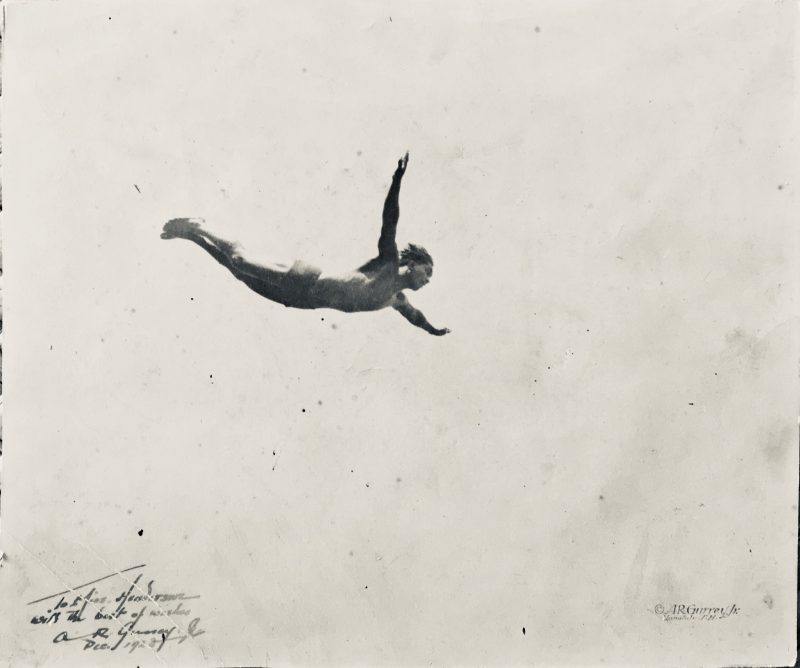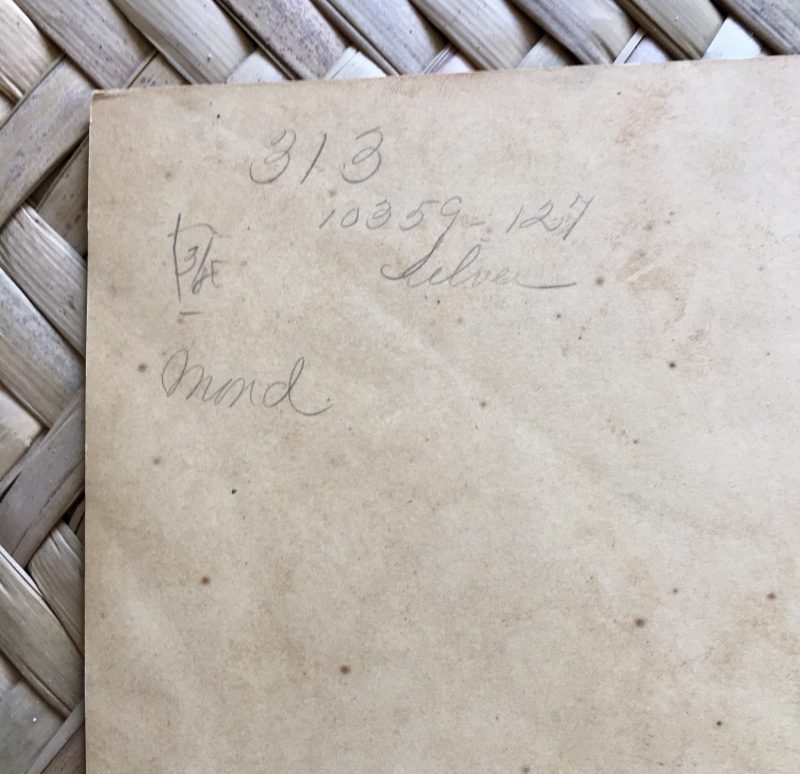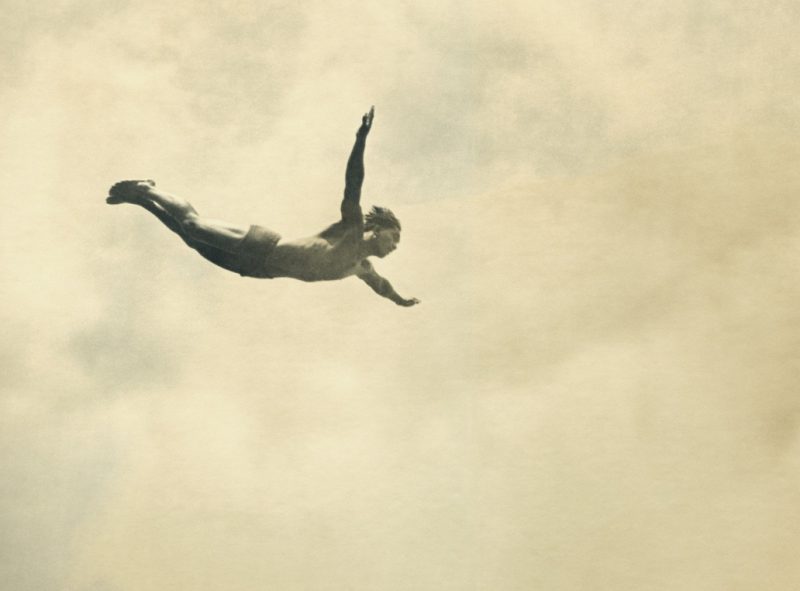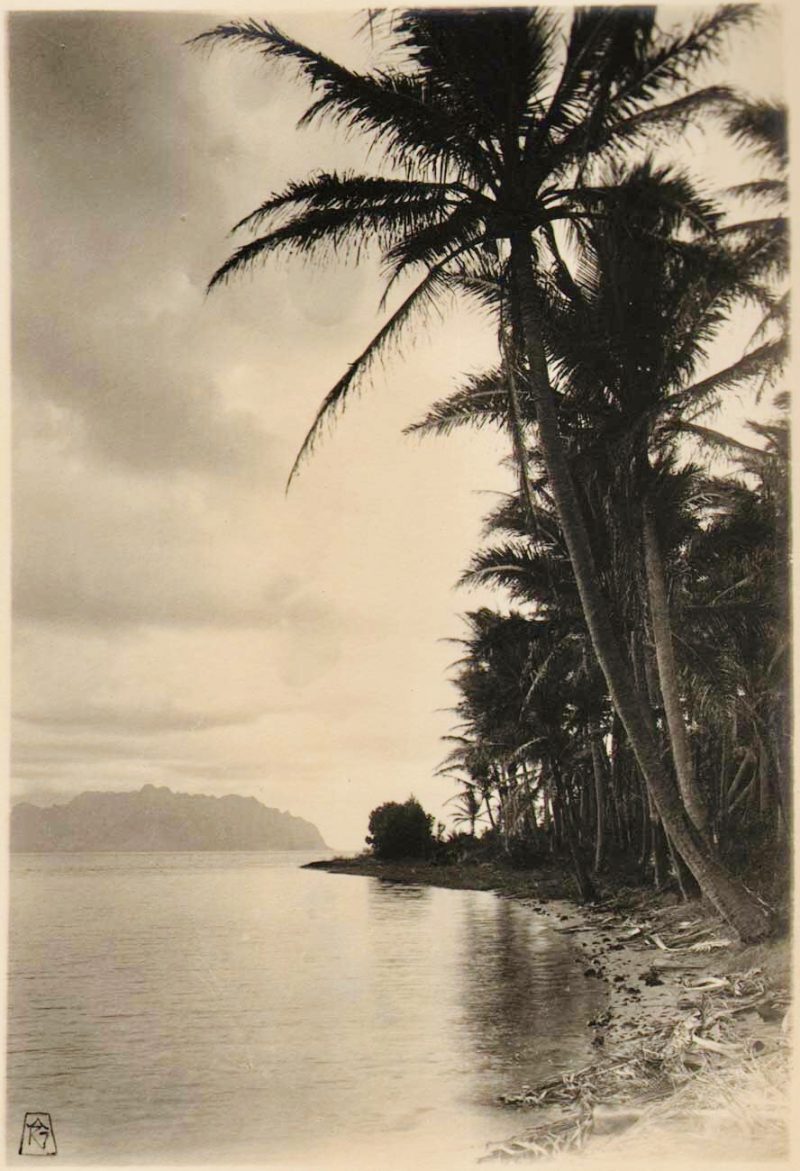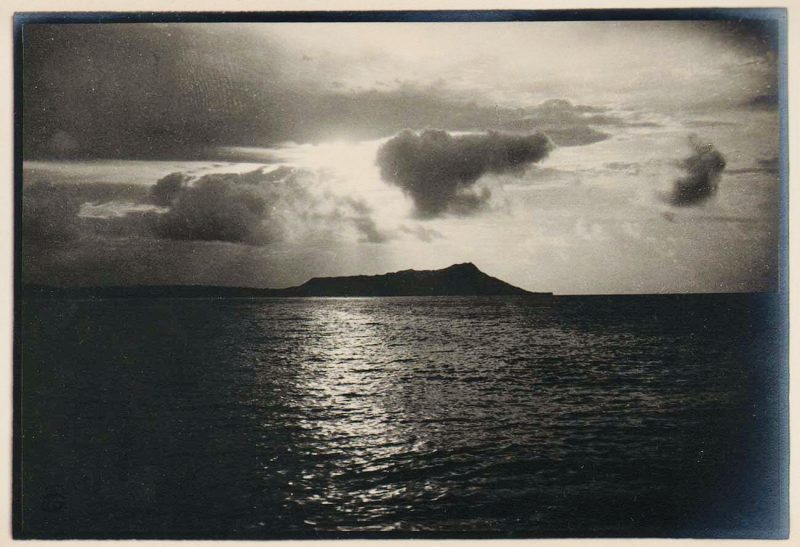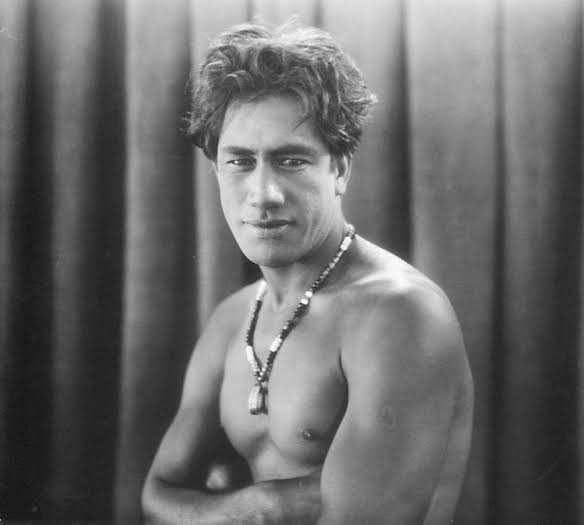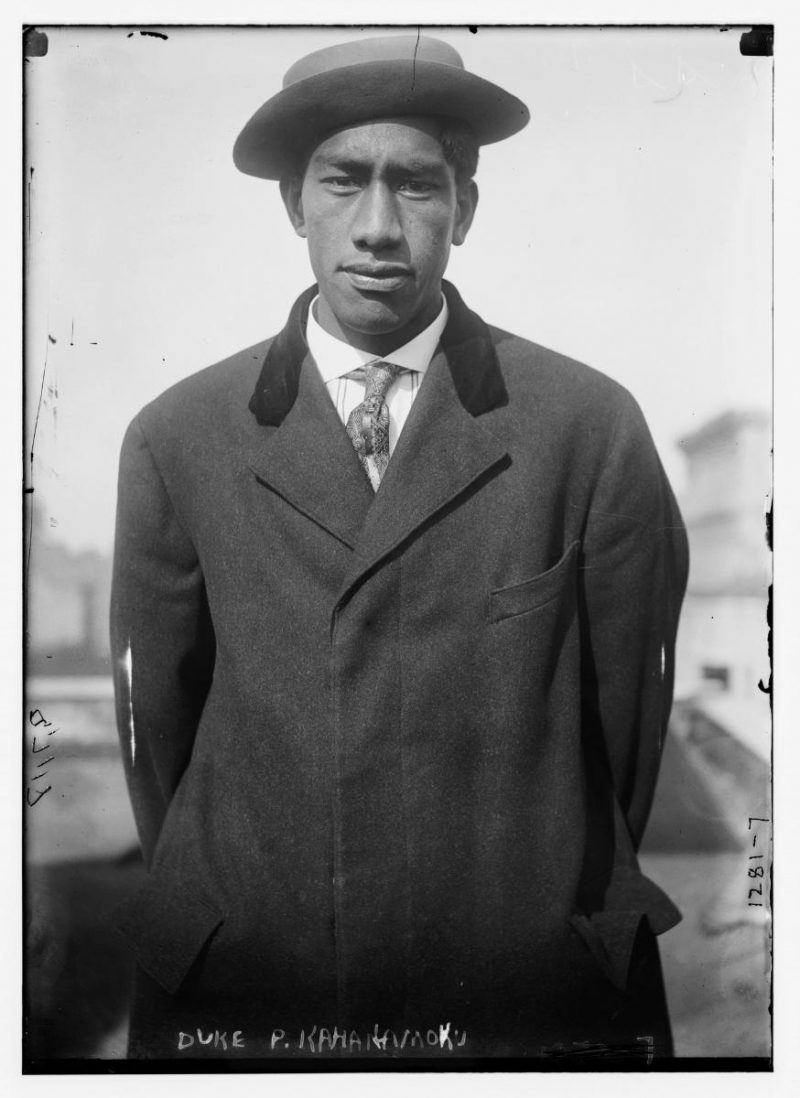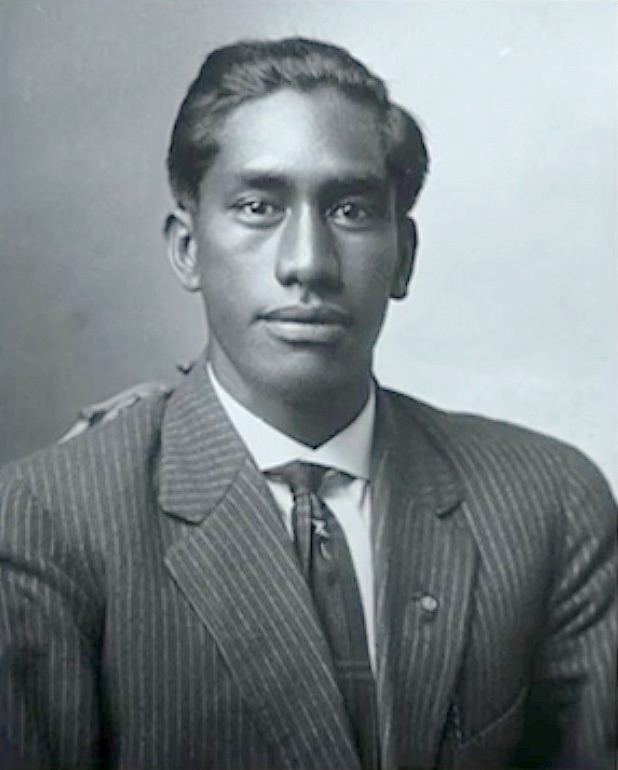SOLD. Authentic Photograph of Diver by A.R. Gurrey 1923.
Authentic Vintage Rare Photograph by A.R. Gurrey, measures 8×10 inches. The diver is the infamous surfer Duke Paoa Kahinu Mokoe Hulikohola Kahanamoku, a legend who goes by many names—The Big Kahuna, The Godfather of Surfing, Ambassador of Aloha, and simply, The Duke.
Photo has s igns of aging, discolouration & creases but a very rare & beautiful find. Handwriting by the photographer: ‘To Miss Henderson with the best of wishes. A.R. Gurrey Jr. Dec. 1923’ with additional artist’s stamp at lower right ‘Copyright A.R. Gurrey Jr. Honolulu T.H.’, handwritten on verso of print: ‘313 10359-127 Silver. Mond. & initials (I believe). Please see research links below to learn slot more about this fascinating photographer).
Extremely Rare: Verbally appraised a
Private Collection.
#WATERMANTHEMOVIE #DUKEKAHANAMOKU #WATERMAN #DUKE
NOW FEATURED IN A DOCUMENTARY:
A.R. Gurrey Jr.
“These photographs of surf riding are from the negatives of Alfred R. Gurrey, Jr., and some of the results of three years work in surf photography. It necessitated going right out against the incoming surf, right at its height, and meant invariably a swamping of the canoe and soaking all in it. Mr. Gurrey felt amply repaid for his days outing if at the end of the day he returned with his camera and one unspoiled negative out of twelve.”
From “Our Navy” Magazine 1912
A. R. Gurrey, Jr.
By Joel T. Smith
& Sandra Kimberley Hall
Alfred Richard Gurrey, Jr. was born in Kansas on December 21, 1874. He graduated from the University of California, Berkeley and worked as a civil engineer in the San Francisco Bay area for seven years. Right at the turn of the 20th Century he relocated to Hawaiʻi, joining his parents who had moved to Honolulu in 1899.
Gurrey’s father, Alfred Sr. (1852-1944), was a fascinating character. He was the principal insurance adjuster for the Island chain, drafting the first fire ratings and maps for the city of Honolulu. He also served as the Secretary of the Board of Underwriters for the entire Territory of Hawaii. This was a highly important and influential position; but while insurance was A.R. Sr.’s business it was not his passion. His real love was art.
The younger Gurrey had grown up in a household surrounded by paintings and sculptures. A.R. Sr. was an accomplished artist who, after retiring from the insurance business, achieved significant fame for his oil paintings, notably seascapes. Today his works command hefty prices from museums, galleries and collectors. With such a gifted father it was perhaps inevitable that Gurrey would be drawn to the world of art.
Upon arriving in Hawaiʻi Gurrey Jr. started working as a surveyor for the Honolulu Rapid Transit Company. He soon quit this job and left engineering completely. He became a gallerist and businessman, establishing “A. R. Gurrey, Jr. in 1902. At first he appears to have focused on furniture, interior decorations, reproductions of Old Masters, picture frames, Art Pottery and Artistic Publications. This was the first of three galleries that would eventually became Gurreyʻs LTD. in 1909.
This eclectic gallery swiftly became the focal point of Hawaii’s burgeoning art scene. It was a salon and meeting place for artists old and new as well as an art dealership. Gurrey was particularly well regarded for his support of local talent. He not only showcased their work, but also offered jobs, meals, and the occasional rent check when times were hard. Among the many renowned artist he helped over the years where Don Blanding, lionel Walden, Charles W. Bartlett and photographer Tai Sing Loo.
From all the reminiscences and articles about A.R. Gurrey, Jr. a picture emerges of a man with a technical bent, an artistic sensibility and a caring heart. At a time when race was a determing factor in virtually all aspects of society and buisness, A. R. showed himself to be surprisingly color blind. he mentored a young chinese Hawaiian named Tai Sing Loo and even had Tai accompany him on a buying trip to the mainland in 1909. Gurrey demanded that the hotels where he stayed at accomodate Tai as well, which suprisingly they did. Tai went on to become the Official Photographer for the U.S. Navy, and this too began with A. R. Gurrey.
By 1909 Gurreyʻs Ltd. listed itself as offering: “art, books, pictures & framing, oriental goods, and photographic development and printing” The latter is particularly significant as photography was beyond the purview of most galleries and was undoubtedly inspired by Gurreyʻs wife, Caroline Haskins Gurrey (1875-1927) (For more informtion on Caroline visit the “C.H. Gurrey”page)
Caroline was a remarkable woman. She had moved to Honolulu from California and joined the studio of J. J. Williams as a photographer in December of 1898. An unusual occupation for a woman at the time. She went on to become one of the most successful commercial photographers in the island chain, specializing in exquisite, studio based portraits. Caroline gained national recognition with her study of mixed race children, “The Hawaiian Type Series”.
“Mrs. A.R. Gurrey, Jr., has just completed a set of about fifty of the most faithful, and also remarkable, photographic studies of Hawaiian types ever displayed in these islands… The collection forms a complete pictorial history of the Hawaiian race that has pronounced scientific as well as art value. This set will go forward with the Hawaiian exhibit for display at the Yukon Exposition in Seattle, after which it will become the property of the Smithsonian Institution. The display as it stands represents a serious work and not a fad. It is something in which Hawaiians may reasonably feel a pride in seeing their race so faithfully portrayed.”
The Honolulu Star, April 1909.
Caroline and A. R. were married on June 11, 1903, shortly after the first gallery opened. Eventually the galleries would take on a photographic focus when he bought out the Hawaiian Photo Supply Co. in 1908 and then in November of 1909, Gurrey Ltd. opened as the Hawaiian agent for Ansco films and cameras and Cyco printing paper. Soon thereafter Gurrey won the contract to handle all the photographing, developing and printing for the U.S. Naval Yard at Pearl Harbor.
There is no indication that Gurrey ever received formal training in photography and he unquestionably benefited from his wifeʻs knowledge and encouragement, but their work was quite different. Caroline worked carefully composed and lit subjects in her studio, while A. R. did virtually all of his photo work outdoors.
The Father of Surf Photography
By 1910 photography had gone through monumental technological advancement over the last few decades. With George Eastman’s invention of film and the introduction of small hand held “Kodak”cameras with preloaded film, photography was available for the first time to the masses and this camera become a standard item for the visiting tourist at Waikiki.
The first documentable photos of he’e nalu (surf sliding) where done on Niʻihau by Dr. Henry C. Bolton in 1890. Over the next few decades Hawaiian photographers J. J. Williams, Frank Davey, Ray Jerome Baker and Alexander Hume Ford documented the revival of the sport. They were joined by motion picture crews from Thomas Edison and the French Pathé Frères company. Their images are valuable from an historical standpoint, but the real breakthrough was about to occur.
There was one aspect of Gurrey that separated him from his contemporaries — he was an avid surfer.
Gurrey was a member of the Hui Nalu, the surfing club founded by Duke Kahanamoku and his friends. It was a proud bastion of Native Hawaiians and hapa-haoles who held meetings under the Moana Hotelʻs hau tree. It says much about Gurrey that he chose the Hui as his club, as his parents belonged to the more socially prestigious Outrigger.
Gurrey maintained a strong professional engagement with his friend Duke Kahanamoku, who was Gurreyʻs favorite photographic subject. Gurreyʻs photographs are the earliest known photos of Duke surfing, taken of the relatively unknown athlete before his first Olympics in 1912. Indeed, A.R., Jr.’s most famous photo is the soaring Duke executing a swan dive from the 100 foot mast of a sailboat. Gurrey also snapped the classic shot of Duke posed with his surfboard at Waikiki. The Hawaii Promotion Committee turned this photo into a postcard and sold it to raise money for Duke’s first Olympics. But the key here is that Gurrey knew firsthand what surfers and surfing were all about. His intimate involvement gave him an understanding of the sport beyond any cameraman of his era, and his practical experience with the U.S. Navy contract gave him confidence filming at sea and aboard water craft.
Gurrey realized that to accurately portray surfing he had to get up close and personal with the wave riders themselves – and this is what ultimately distinguishes his work. Virtually all of his surfing photos are “water shots.”

From the angles used, the proximity to his subjects, and the fact that the moving elements are sharply in focus, it is apparent that Gurrey ventured into the surf itself – taking the photos from a canoe racing alongside the surf riders rather than just going out to the end of the Moana Pier. Given the quality of his results this was clearly a breakthrough for surf photography.
The action shots in “The Surf Riders of Hawaii” are all the more remarkable when one considers the primitive state of camera technology circa 1910. Sports photography had just arrived with the controversial marathon photo of Dorando Pietri at the 1908 Olympics. And water housings to protect the camera were unknown, certainly not commercially available.
Although we cannot be certain what equipment Gurrey used, it would invariably be an Ansco product as he was their official agent and dealer in Hawaiʻi. Several of their versatile “Folding” cameras utilized roll film that could be loaded in daylight and were small enough to handle (and protect) in a shaky canoe.
Regardless of the equipment he chose, the results are what matters, and here Gurrey excelled. His rare blend of technical prowess, aesthetic appreciation and “wave knowledge” lifted his work above the others and set the standards of surf photography for years to come.
A.R. Gurrey, Jr. essentially pioneered surf photography as we know it today.
The Book

“The Surf Riders of Hawaii” combines stunning photographs with romantic poetry from Lord Byron and Gurrey’s own descriptive prose. The photos are all technically proficient – beautifully composed and fastidiously rendered. Each shot depicts a surfer or surfers riding the waves at Waikiki. From the standpoint of surfing history these images are invaluable. They provide clear documentation of the sport just as it was emerging from a century long period of decline. But they are much more than a just a celluloid chronicle. The eight (8) photos that comprise each of these books actually transcend history through their artistry. A.R. Gurrey managed to impart the intangible with his images; presenting viewers with the true spirit, splendor and visceral joy of wave riding.
For the first time the essence of the surfing experience was displayed on film.
This was a remarkable achievement, particularly given the technical limitations of the time. Gurrey’s photos are unquestionably the finest surf images of the era – and still a thing of rare beauty today.
No one knows how many books were originally produced, or, indeed, exactly when they were produced. Each was hand assembled by the author/photographer some time between 1910 and 1914. Gurrey mounted original photographic prints directly onto heavy paper stock, and then bound the pages together with a colorful cord. This was painstaking work, commanding a great deal of personal attention. His obvious goal was to make every book special – an item precious unto itself. We have been able to verify two “editions” with different paper stock and some slight variation in the selection of photos mounted. This helps make each copy of this book somewhat unique.
“The Surf Riders of Hawaii” today holds a revered place in the world of surfing. It is the first book dedicated to the sport and unquestionably a work of art. At the time of this writing only eight (8) copies of the book are known to be in existence. But the importance of this book is not in its scarcity or even the personalized touch of its manufacture. It is the wonderful content.

The Legacy
A.R. Gurrey achieved some contemporary renown for his work. His pictures were regulary featured in Hawaiian and national publications (list below), including the complete “Surf Riders” of Hawaii” in St. Nicholas Magazine (1915), which at the time was one of America’s most popular children’s monthlies. But it was the Honolulu based Mid Pacific Magazine that most frequently displayed Gurrey’s images including Duke on the inaugural cover. Both A.R. and his wife Caroline were regular contributors to this fine journal in its early years.
Caroline’s fame continued to grow and her photo studio thrived, but for some reason Gurrey seemed to stop taking photographs shortly after the publication of “Surf Riders.” He concentrated on his art gallery, but that tale does not have a happy ending. Gurrey’s Ltd. struggled financially for many years and finally closed its doors in 1923. After a year of unemployment Gurrey glumly reverted to his father’s business, taking a job as an insurance surveyor. The rumor at the time was that Caroline was actually supporting the family.
During this unhappy period the Gurrey home suffered both a fire and a flood. It is believed that all of their original negatives were lost. and then Caroline died at age 52 in 1927. Perhaps this was the final straw in a succession of dream shattering events. Gurrey died in 1928, at the untimely age of 53.
A.R. Gurrey, Jr. became a forgotten man soon after that. People often confused him with his father, who outlived him by almost two decades. And his wife Caroline became so well known that she was commonly given credit for the fine photographs her husband produced. His name and work where virtually unknown untill the publication of a Surfers Journal article in 2005, by Joel T. Smith & Sandra K. Hall. Still outside of a few collections most of his pictures have not been seen for almost 100 years. But his artistry speaks for itself. A.R. Gurrey is a man who fully deserves the recognition which is at last coming his light.

And I have loved thee, Ocean! and my joyOf youthful sports was on thy breast, to beBorne, like thy bubbles, onward; from a boyI wantoned with thy breakers, – they come to meWere a delight; and if the freshening sea.Made them a terror, t’was a pleasing fear;For I was as it, were a child of thee,And trusted to thy billows far and near,And laid my hand upon thy mane,As I do here.
From “Childe Harold”By Lord Byron.
Published surfing works of A. R. Gurrey Jr.
Self Published Books:
Idyls of Hawaii. (Honolulu, HI. circa 1910-1915) Hand made, cord bound book of 11 Hawaii photos with prose. 2 photos of an outrigger, possibly the family canoe “Kamaaina” that was donated to the Outrigger Canoe Club, as noted in The Hawaiian Star newspaper, Dec. 8 1908.
The Surf Riders of Hawaii. (Honolulu, HI. circa 1911-1915)
Books:
Old Time Hawaiians and Their Work. By Mary S. Lawrence
Frontispiece by Caroline Haskins Gurrey and numerous photos by A. R. Gurrey Jr.
Magazine Articles: Note during this era most photographs where not credited.
Illustrated London News August 1910. 2 Photos one of Duke taken same day as Gurreyʻs most popular photo of Duke as well as one more photo that appears in The Surf Riders of Hawaii, credited as Gurney. Story by A. H. Ford with 4 photos by him and 1 manipulated photo by J. J. Williams. (GALLERY)
Mid Pacific Magazine:vol. 1 no. 1: Jan. 1911 Cover shot of Duke (GALLERY) Frontpiece: Photo of Duke with Charlie Little or Marston Campbell on his shoulders. Main article “Riding the Surfboard” by Duke Paoa (Kahanamoku).
“Honoluluʻs Busy Corner” Page 122 “Next to Culmanʻs is “Gurreyʻs.” This Art and Photo Shop is the home of the Hawaiian Roycroftes, where you can see the work of the leading artists of the Islands, small views, native types and surf riders and other objects of art. Besides being the leading art shop, they are agents for Ansco Cameras and Cyko paper, with a developing and printing department that can not be excelled.”
vol. 1 no. 2: Feb. 1911. 13 photos accompany second part of Duke Paoa (Kahanamoku) article “Riding the Surfboard”. Only one credited to “Ferris” other photos not credited, one of Duke is by Gurrey, some may be by A. H. Ford?
vol. 1 no. 3: March 1911. Notes A. R. Gurrey Jr. has “taken the best surfing picture yet made.”
vol. 2 no. 2: Aug 1911. Frontpiece: “Childe Harold” with Duke photo
vol. 4 no. 5: Dec 1912. Photo of Duke as used in the Gray Version of The Surf Riders of Hawaii.
vol. 9 no. 4: April 1915. 12 Photos accompaning article “Surf Board Riding in Hawaii” by Lorrin P. Thurston, none credited, at least 2 are by A.R. Gurrey Jr.
vol. 15 no. 3: March 1918. 3 Photos (None credited) Along with the article “Surf Riding – The Sport with a Thrill” by Req. L. “Snowy” Baker. One by Gurrey of Duke with Charlie Little or Marston Campbell on his shoulders.
Our Navy Magazine November 1912. Edited version of “Riding the Surfboard” by Duke Paoa (Kahanamoku) with 4 photos by Gurrey used in The Surf Riders of Hawaii.
Outing Magazine April 1914. “Riding the Surf at Waikiki” by George Marvin, 13 photos “illustrated with photographs by Gurrey”, two of Duke.
St. Nicholas Magazine Aug. 1915. The Surf Riders of Hawaii
10 photos, with same text and poem as books with 1 added.
National Geographic Magazine 1919. “Riding the Surf at Honolulu, Hawaii.” 1 photos, short text on “Hawaiiʻs distinctive sport” credit A. R. Gurrey.
Duke Kahanamoku, Honolulu, 1915. Photograph by A.R. Gurrey Jr.
A.R. Gurrey Jr. : Surf Riders of Hawaii, 1915.
Gurrey Jr, A.R. : The Surf Riders of Hawaii.
St. Nicholas Magazine
Ilustrated Magazine for Boys and Girls.
The Century Co., New York.
Volume XLII, August, 1915, pages 923-927.
Introduction.
These photographs were originally printed as a collection by A.R. Gurrey Jr in his self-published The Surf Riders of Hawaii, circa 1911.
Each copy consisted of a varied selection of eight untitled hand-printed photos on pasted boards, with one page of descriptive text and one with a stanza from Byron’s poem Childe Harold.
The 1915article reproduces the text and poem, however it has two extra photographs.
Each page assigns coyright to A.R.G., JR.; and each page and image has its own black line border, not reproduced.
The uploaded images are scaled approximtely to the size as printed, and I have assigned the numbers and titles in [brackets].
This was not the first surf riding article in St. Nicholas, Alexander Hume Ford’s article on Pacific sports and games, A Boy’s Paradise in the Pacific, was featured in the August 1908 edition.
Some of the images appeared in other publications of this period, notably photograph 5, Duke Kahanamoku at Waikiki, which was used extensively in advertising for Gurrey’s Honolulu photographic studio from the end of 1910.
It was printed on the cover of the first edition of The Mid-Pacific Magazine in January 1911, and as the frontpiece of Volume 2 Number 2, with the stanza from Byron’s Childe Harold.
The photograph was possibly the template for a coloured illustration used by the Hawaiian Promotion Committee to publicise their Floral Parades and Mid-Winter Carnivals 1911-1914, and later appropriated to promote Duke’s tour of Australia in 1914-1915.
The first edition also printed a photograph, Riding the Surfboard at Waikiki Beach, illustrating a tandem shoulder carry, “Copyright 1910 A.R. Gurrey Jr.,” very similar to photograph 6.
In 1912, The Mid-Pacific Magazine published photograph 3 in Volume 4, Number 5, titled “Duke Paoa Kahanamoku, Hawaii’s Champion Swimmer of the World,” with copyright by Gurrey.
As most photographs indicate that Duke was a natural-footer, here he is riding goofy-foot, or rather switch-foot (unless the negative was flopped).
This may have been to advantage the photographer, the most dramatic shots are those with the surfer facing the camera, ideally framed by Diamond Head, as in photographs 1 and 10.
Photographs 1 (heavily cropped) and 7 were reprinted, in what was probably a syndicated article, by the Dakota County Herald, September 10, 1914, page 3.
Photograph 1 was printed in a National Geographic Magazine article, The Geography of Games, in August, 1919.
The rapid adoption of Kodak’s Box Brownie is perhaps illustrated by the numerous photographs (along with illustrations, poems, and stories) contributed by younger readers for awards in The St. Nicholas League.
For example, the, The Water at Twilight (a photograph of a breaking wave) on page 945by Dorothea Setzer of Michigan, aged 11, who was awarded a silver badge.
For a full reproduction of the book(s) and detailed analysis, see Tim DeLaVega’s excellent:The Surf Riders of Hawaii
http://surfridershawaii.blogspot.com.au/
Page 923THE SURF-RIDERS OF HAWAII
[1. Goofy-foot with spread arms; Diamond 
[2. Two natural-footers, both crouched on a large wave.]Page 924
As the great ocean roll strikes the reef at Hawaii, all the force arid energy of a thousand miles is halted in its course.
Maddened at its unknown foe, it throws its billowing form headlong over the reef; boiling and churning it rushes along, dissipating its strength in the quiet pools until at last it dies, a mere ripple, on the beach.
 [3. Duke Kahanamoku, switch-foot. ] [3. Duke Kahanamoku, switch-foot. ] | What are those swiftly moving forms gliding over the surface of the foam-specked waters like a school of dolphins- their bronze bodies glistening in the sunlight? Are they a company of sea-nymphs or mermen? They are a merry band of water-lovers- the Surf-riders – and no legendary water-sprite ever rode the waves with more joyous abandon than these.Far out at sea, there is a faint unevenness silhouetted against the sky. The watchful eye of the boy has seen it- you hear a penetrating, low, weird whistle- the signal that a “big one” is coming. Out they speed. Outstretched on their boards they sweep the water with their hands, mounting wave after wave, gliding into the glittering troughs beyond, until they reach the reef. On comes the surf! It strikes- arches, curves, and falls! And as it plunges forward, like a frightened sea-horse, this fearless surf-rider is at its mane. With board pointed shoreward he rides this untamed fury. He stands erect with arms outstretched, triumphant, with a glittering inclined plane before him. On, on he sweeps, tobogganing in an opalescent sea, plowing up showers of liquid jewels into the sunlight.The wave is spent, the rider drops astride his board, and, with the grace of a sea-gull turning in its flight, he heads for the reef again. |
Thus plays this child of the sea, happy and care-free, until the great orange sun drops below the horizon.
Text and photographs copyrighted by A. R. Gurrey, Jr., Honolulu, T. H.Page 925
[4. Natural-footer; with western shoreline (present-day location of Royal Hawaiian) on right.]

[5. Duke Kahanamoku, as used in Gurrey’s ads]Page 926
[6. Tandem shoulder carry, possibly Duke with boy on his shoulders, possibly Charlie Little]

[7. Two natural-footers, sliding left]Page 927
[8.Two riders slide right, and two sliding left.]

[9. Headstand and four paddlers.]

[10.Goofy-foot on curling left-hander, with Diamond Head in the background.]
Page 945AUGUST
(A collection of photographs, illustrations, poems and stories contributed by younger readers for awards in The St. Nicholas League.)
 | The Water at Twilight. [Breaking wave.]By Dorothea Setzer, age 11, Michigan. Silver badge. |
Introduction. Images posted by Scott Emerson on surf blurb
Mon, 6 Jun 2011 11:52:24 -0700:
Sotheby’s Auction
Lot 136: booklet
Fine Books and Manuscripts [N08755]
New York, 17 June ’11 10:00AM EDT
Estimate 5,000 – 7,000
Gurrey, A. R. Jr. (First book dedicated to surfing)
884- The Surf Riders of Hawaii (Honolulu: A.R. Gurrey Jr. 1911-14:t) (SB)
(Four known copies)
8 surfing photos, that vary between books.
The first surfing book, self-published with hand printed photos on boards.
Photos of surfing at Waikiki with short text on surfing and a stanza from Byron poem “hand printed photos on boards.”, and ends with a photo of Duke.
Gurrey who surfed and pioneered water photography is credited as the first surfing photographer.
885- “Childe Harold” Mid-Pacific Magazine
Timothy DeLaVega noted:
Desoto Brown sent over some interesting info on what the Bishop Museum’s copy is like
“The Bishop Museum copy is very different as can be seen by this list.
We only have single photos per page; no doubles.
And no blank pages either.
Ours also appears to have only 3 of the same photos as the listing in the message below.
| Page 1 Page 2 Page 3 Page 4 Page 5 Page 6Page 7 Page 8 Page 9 Page 10 Page 11 Page 12 | Title page Lord Byron poem Man with arms out; Diamond Head at left (listed below also on p. 3) Text about surfriders Full-length, fairly close view of Duke on board with his arms out (as used in Gurrey’s ads) (listed below on p. 11) Duke (presumably) with boy on his shoulders (identified in another copy of this photo in our collection as Charlie Little, listed below on p. 9) One man, with right arm down straight and left arm up, bent at elbow; with shoreline (present-day location of Royal Hawaiian) partly visible on right Two men, both crouched on their respective boards, with man on right reaching out to touch the nose of the board on the left Duke (presumably) with arms partly out, with Diamond Head in much of the background. Two men on foamy breaking wave, each with arms out at different angles One man standing on his head with 5 other guys on same wave but all others still flat on their boards Blank |
Cover
 | Cover: Gurrey Jr, A.R. : Surf Riders of Hawaii. A.R. Gurrey Jr., Honolulu, 1911-1914.Image courtesy of Scott Emerson. |
Page 3
Also printed in The Mid-Pacific Magazine
Published by Alexander Hume Ford, Honolulu, Territory of Hawaii,
Volume 2, Number 2, August,1911, frontpiece.
 |
And I have loved thee, Ocean! and my joy
Of youthful sports was on thy breast, to be
Borne, like thy bubbles, onward; from a boy
I wantoned with thy breakers, – they come to me
Were a delight; and if the freshening sea.
Made them a terror, t’was a pleasing fear;
For I was as it, were a child of thee,
And trusted to thy billows far and near,
And laid my hand upon thy mane,
As I do here.From “Childe Harold”
Lord Byron.Photo by A. R. Gurrey, Jr.Page 6
Desoto Brown: “Full-length, fairly close view of Duke on board with his arms out (as used in Gurrey’s ads) (listed below on p. 11)”
| Right: Gurrey’s Billboard, printed in The Mid-Pacific Magazine Published by Alexander Hume Ford, Honolulu, Territory of Hawaii, Volume 1, Number 1, January,1911, page 133.Pioneer Adv. Company On Top … CYKO The Modern Photographic Paper Developing and Printing Gurrey’s Ltd. Fort Near HotelReproduced in many subsequent editions. |  |
| The image was also used on the first edition of The Mid-Pacific Magazine Published by Alexander Hume Ford, Honolulu, Territory of Hawaii, Volume 1, Number 1, January,1911. Cover right. |  |
Page 7
Desoto Brown: “Duke (presumably) with boy on his shoulders (identified in another copy of this photo in our collection as Charlie Little, listed below on p. 9)”
| Similar photograph (?) printed in: Kahanamoku, Duke Paoa: Riding the Surfboard. The Mid-Pacific Magazine Published by Alexander Hume Ford, Honolulu, Territory of Hawaii, Volume 1, Number 1, January,1911, page 2. Image right:RIDING THE SURFBOARD AT WAIKIKI BEACH, HONOLULU, TERRITORY OF HAWAII. Copyright 1910 A.R. Gurrey Jr. |  |
 | Back Cover: Gurrey Jr, A.R. : Surf Riders of Hawaii. A.R. Gurrey Jr., Honolulu, 1911-1914.Image courtesy of Scott Emerson. |
 Kampion: Stoked (1997) page 38. Credited to Bishop Museum |  Thoms: Surfmovies (2000) page 22. |

